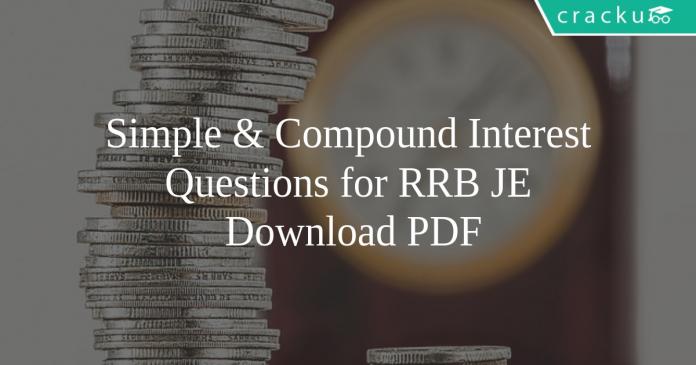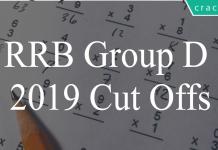Simple & Compound Interest Questions For RRB JE PDF:
Download Top 15 RRB JE Simple & Compound Interest Questions and Answers PDF. RRB JE Maths questions based on asked questions in previous exam papers very important for the Railway JE exam.
Download Simple & Compound Interest Questions For RRB JE PDF
Download RRB JE Previous Papers PDF
Question 1: A lends Rs.15000 to B at 15% per annum Simple Interest for 2 years. B immediately lends it to C at 20% per annum Simple Interest for 2 years. Find the profit of B.
a) Rs.2500
b) Rs.1700
c) Rs.1400
d) Rs.1500
Question 2: A person invested an amount of Rs.15000 at 6% per annum Simple Interest for 2 years. How much more interest he would have earned if he had invested the same amount in Compound Interest at same rate of interest and same period?
a) Rs.42
b) Rs.48
c) Rs.54
d) Rs.62
Question 3: Value of rate of interest and time period(in years) are equal.If simple interest on certain principal value is (25/49) times the principle amount, then what is the rate of interest ?
a) 50/7 %
b) 25/7 %
c) 30/7 %
d) 40/7 %
18000+ Questions – Free SSC Study Material
Question 4: At simple interest for 5 years principal amounts to Rs 750 and for 7 years it is Rs 900 then what is the principal value ?
a) 400
b) 375
c) 359
d) 425
Question 5: Rohit invested Rs.20000 in Compound Interest for 2 years. The rate of interest is 4% for first year and 8% for second year compounded annually. Then find overall interest earned.
a) Rs.2442
b) Rs.2240
c) Rs.2048
d) Rs.2464
RRB JE Free Mock Test (latest pattern)
Question 6: A person invested certain amount of money in Scheme A which offers 10 p.c.p.a Simple Interest for 2 years. Had he invested in Scheme B which offers 10 p.c.p.a Compound Interest for same time period, he would have earned Rs.12 extra. Then find the sum of money.
a) Rs.1000
b) Rs.1200
c) Rs.600
d) Rs.6000
Question 7: What is the rate(per annum) of compound interest at which a sum of Rs. 15000/- becomes Rs. 16391/- in 3 years.
a) 3
b) 4
c) 5
d) 6
Question 8: If the compound interest on a certain sum of money for 3 years at 2% per annum is Rs. 1530.20/- Calculate the Simple interest(in Rs.) on the sum of the money at the same rate and for the same time.
a) 1200
b) 1400
c) 2500
d) 1500
Question 9: Calculate the compound interest on the sum of the money at the same rate and for the same time, If the simple interest on a certain sum of money for 2 years at 6% per annum is Rs. 432.
a) 464.96
b) 484.96
c) 444.96
d) 454.96
Question 10: There are two schemes-Scheme A and Scheme B. Scheme A offers 8% Simple Interest. Scheme B offers 7% per annum Compound Interest. Which scheme offers more interest for overall 2 years?
a) A
b) B
c) Both are equal
d) Can’t be determined
Daily Free Online Tests for RRB Exams
Question 11: Calculate the time period(in years) if the compound interest on Rs. 40000 @ 4% p.a. is 4994.56.
a) 2
b) 3
c) 3.5
d) 4
Question 12: The difference between Simple Interest and Compound interest of certain amount at 15% per annum for 2 years is Rs.9000. Then find the sum.
a) Rs.400000
b) Rs.250000
c) Rs.40000
d) Rs.150000
Question 13: Find the difference between compound interest and simple interest on 30000/- at 12% per annum for 2 years ?
a) 342
b) 4320
c) 432
d) 3420
Question 14: The compound interest of a sum of Rs.8000 at 2.5% per annum is Rs.405. Then, find the number of years.
a) 2.5 years
b) 1.5 years
c) 3 years
d) 2 years
Question 15: A borrowed a sum of Rs.5000 at 6% simple interest for 3 years. He then lent it immediately to B at 8% simple interest for 3 years. Then find his gain for 1 year.
a) Rs.140
b) Rs.100
c) Rs.240
d) Rs.180
General Science Notes for RRB Exams (PDF)
Answers & Solutions:
1) Answer (D)
Profit of B = $\dfrac{15000\times20\times2}{100} – \dfrac{15000\times15\times2}{100} = 6000-4500 = Rs.1500$
2) Answer (C)
Given, Amount = Rs.15000
Simple Interest at 6 p.c.p.a. for 2 years will be $\dfrac{15000\times6\times2}{100} = Rs.1800$
Amount at the end of 1st year at 6 p.c.p.a Compound Interest = 106% of 15000 = Rs.15900
Amount at the end of 2nd year at 6 p.c.p.a CI = 106% of 15900 = Rs.16854
Total Compound Interest = 16854-15000 = Rs.1854
Therefore, Extra amount of money he would have earned = 1854-1800 = Rs.54
3) Answer (A)
Given rate of interest r= time period t
(25/49)P=(P*r*r)/100
$r^{2}$=2500/49
r=50/7 %
4) Answer (B)
For 7 years amount=900
For 5 years amount=750
Interest for 2 years =900-750
=150
Interest for 1 year=75
Interest for 5 years=5*75
=375
Principal value at the beginning is 750-375=375
Hence, option B is the correct answer.
5) Answer (D)
Amount received in first year = 104% of 20000 = Rs.20800
Amount received in second year = 108% of Rs.20800 = Rs.22464
Hence, Total Compound Interest = Rs.22464 – Rs.20000 = Rs.2464
6) Answer (B)
Let the principal be Rs.100
Interest earned from Scheme A $= \dfrac{100\times10\times2}{100} = Rs.20$
Amount earned from Scheme B:
For 1st year → $110$% of $100 = Rs.110$
For 2nd year → $110$% of $110 = Rs.121$
Interest earned from Scheme B $= 121-100 = Rs.21$
Given Difference between SI and CI $= Rs.12$
$Re.1 → Rs.12$
$Rs.100 → ?$
Hence, Total Interest $= 100*12 = Rs.1200$
7) Answer (A)
Principal(P) = 15000
Rate of Interest (R) = ?
Time period(t) = 3 years
$ Amount = P(1+ \Large\frac{R}{100})^{t} $
$ 16391 = 15000{(1+ \Large\frac{R}{100})^{3}}$
$ (1+ \Large\frac{R}{100})^{3} = \Large\frac{16391}{15000} $
$ (1+ \Large\frac{R}{100})^{3}$ $ = 1.0927$
$ (1+ \Large\frac{R}{100})^{3}$ $ = 1.03^3$
$ (1+ \Large\frac{R}{100})^{3}$ = $(\Large\frac{103}{100})^{3} $
$ R = 3$% p.a.
8) Answer (D)
Principal(P) = ?
Rate of Interest (R) = 2%
Time period(t) = 3 years
Given, Compound Interest = 1530.20
$ 1530.20 = P\Large(1+\frac{R}{100})^{t}$ $ – P$
$1530.20 = P[\Large(1+\frac{2}{100})^{3}$ $ – 1]$
$P = \Large\frac{1530.2}{(1.02)^3 – 1} $
$P = Rs. 25,000 /-$
Simple Interest = $\Large\frac{PTR}{100}$
$ S.I. = \Large\frac{25000\times2\times3}{100}$
$ S.I. = Rs. 1500/- $
9) Answer (C)
Simple Interest = $\Large\frac{PTR}{100}$
Principal(P) = ?
Given, Rate of Interest (R) = 6%
Time period(t) = 2 years
$432 = \Large\frac{PTR}{100}$
$P = \Large\frac{432\times100}{TR}$
$P = \Large\frac{432\times100}{12}$
P = Rs. 3600/-
Compound Interest is calculated by
$C.I. = P(1+\Large\frac{R}{100})^{t}$ $- P$
$C.I. = 3,600(1+\Large\frac{6}{100})^{2} -$ $3600$
Compound Interest = Rs. 444.96/-
10) Answer (A)
Effective Simple Interest for Scheme A for 2 years $= 8\times2 = 16$%
Effective Compound Interest for Scheme B for 2 years $= 7+7+\dfrac{7\times7}{100} = 14+0.49 = 14.49$%
Hence, Scheme A offers more interest than Scheme B.
11) Answer (B)
Given the Principal(P) = Rs. 40,000/-
Rate of Interest (R) = 4%
Time period(t) = __ years
Compound Interest = 4994.56/-
$CI = P(1+\frac{R}{100})^{t} – P$
$CI = 40,000{(1+\frac{4}{100})^{t} – 1}$
$ 4994.56 = 40,000{(1.04)^t – 1}$
$ \Large\frac{4994.56}{40,000}$ = $(1.03)^t – 1$
$ \Large\frac{4994.56}{40,000} +$ 1 = $(1.03)^t $
$\Large\frac{44994.56}{40,000}$ = $(1.03)^t $
$t = 3 years$
12) Answer (A)
Let the sum of money be Rs.10000
Simple Interest at 15% per annum for 2 years will be:
$\dfrac{10000\times15\times2}{100} = Rs.3000$
Amount at the end of 1st year with Compound Interest = 115% of Rs.11500
Amount at the end of 2nd year with Compound Interest = 115% of 11500 = Rs.13225
Total Compound Interest = 13225 – 10000 = Rs.3225
Difference between SI and CI = Rs.3225-3000 = Rs.225
Given that the difference = Rs.9000
225 → 9000
10000 → ?
= $\dfrac{10000\times9000}{225} = Rs.400000$
13) Answer (C)
Difference between Compound Interest and Simple Interest for 2 years = $\frac{P(r)^2}{100} = \frac{30000(12)^2}{100} = 432$
So the answer is option C.
14) Answer (D)
Given Principal = Rs.8000
Rate of interest = 2.5%
Compound interest earned in 1st year = 2.5% of Rs.8000 = Rs.200
Amount at the end of 1st year = Rs.8000+Rs.200 = Rs.8200
Compound interest earned in 2nd year = 2.5% of Rs.8200 = Rs.205
Amount at the end of 2nd year = Rs.8200+Rs.205 = Rs.8405
Here, After 2 years, Interest = Rs.8405 – Rs.8000 = Rs.405
Hence, Required number of years = 2 years
15) Answer (B)
Gain for 3 years = $\Large(\frac{5000\times8\times3}{100})-(\frac{5000\times6\times3}{100})$ $= 1200-900 = Rs.300$
Gain for 1 year $= \Large\frac{300}{3}$ $= Rs.100$
DOWNLOAD APP FOR RRB FREE MOCKS
We hope this Simple & Compound Interest Questions for RRB JE Exam will be highly useful for your preparation.





